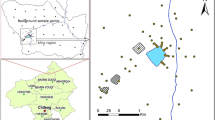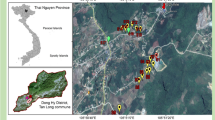Abstract
China is one of the largest producers and consumers of lead and zinc in the world. Lead and zinc mining and smelting can release hazardous heavy metals such as Cd, Pb, Zn, and As into soils, exerting health risks to human by chronic exposure. The concentrations of Cd, Zn, Pb, and As in soil samples collected from a Pb-Zn mining area with exploitation history of 60 years were investigated. Health risks of the heavy metals in soil were evaluated using US Environmental Protection Agency (US EPA) recommended method. A geo-statistical technique (Kriging) was used for the interpolation of heavy metals pollution and Hazard Index (HI). The results indicated that the long-term Pb/Zn mining activities caused the serious pollution in the local soil. The concentrations of Cd, As, Pb, and Zn in topsoil were 40.3 ± 6.3, 103.7 ± 37.3, 3518.4 ± 896.1, and 10,413 ± 2973.2 mg/kg dry weight, respectively. The spatial distribution of the four metals possessed similar patterns, with higher concentrations around Aayiken (AYK), Maseka (MSK), and Kuangshan (KS) area and more rapidly dropped concentrations at upwind direction than those at downwind direction. The main pollutions of Cd and Zn were found in the upper 60 cm, the Pb was found in the upper 40 cm, and the As was in the upper 20 cm. The mobility of metals in soil profile of study area was classed as Cd > Zn ≫ Pb > As. Results indicated that there was a higher health risk (child higher than adult) in the study area. Pb contributed to the highest Hazard Quotient (57.0 ~ 73.9 %) for the Hazard Index.





Similar content being viewed by others
References
Aelion, C. M., Davis, H. T., McDermott, S., & Lawson, A. B. (2008). Metal concentrations in rural topsoil in South Carolina: potential for human health impact. Science of the Total Environment, 402(2), 149–156.
Anju, M., & Banerjee, D. K. (2012). Multivariate statistical analysis of heavy metals in soils of a Pb–Zn mining area, India. Environmental Monitoring and Assessment, 184(7), 4191–4206.
Bi, X., Feng, X., Yang, Y., Qiu, G., Li, G., Li, F., et al. (2006). Environmental contamination of heavy metals from zinc smelting areas in Hezhang County, western Guizhou, China. Environment International, 32(7), 883–890.
Candeias, C., Melo, R., Ávila, P. F., Ferreira da Silva, E., Salgueiro, A. R., & Teixeira, J. P. (2014). Heavy metal pollution in mine–soil–plant system in S. Francisco de Assis–Panasqueira mine (Portugal). Applied Geochemistry, 44, 12–26.
Canfield, R. L., Henderson Jr., C. R., Cory–Slechta, D. A., Cox, C., A., J. T., & P., L. B. (2003). Intellectual impairment in children with blood lead concentrations below 10 μg per deciliter. New England Journal of Medicine, 348(16), 1517–1526.
Ebbinghaus, E., Kreeb, K., & Weinmann–Kreeb, R. (1997). GIS supported monitoring long–termed urban trace element loads with bark of Aesculus hippocastanum L. Journal of Applied Botany, 71(5–6), 205–211.
Gilbert, R. O. (1987). Statistical methods for environmental pollution monitoring (pp. 177–185). New York: John Wiley& Sons, Inc..
Gu, Y. G., Li, Q. S., Fang, J. H., He, B. Y., Fu, H. B., & Tong, Z. J. (2014). Identification of heavy metal sources in the reclaimed farmland soils of the pearl river estuary in China using a multivariate geostatistical approach. Ecotoxicology and Environmental Safety, 105, 7–12.
Ha, H., Olson, J. R., Bian, L., & Rogerson, P. A. (2014). Analysis of heavy metal sources in soil using Kriging interpolation on principal components. Environmental Science & Technology, 48(4), 4999–5007.
Han, F., & Banin, A. (1995). Selective sequential dissolution techniques for trace metals in arid-zone soils: the carbonate dissolution step. Communications in Soil Science and Plant Analysis, 26(3–4), 553–576.
Han, R. S., Liu, C. Q., Huang, Z. L., Chen, J., Ma, D. Y., Lei, L., et al. (2007). Geological features and origin of the Huize carbonatehosted Zn–Pb–(Ag) district, Yunnan, South China. Ore Geology Reviews, 31(1), 360–383.
Huamain, C., Chunrong, Z., Cong, T., & Yongguan, Z. (1999). Heavy metal pollution in soils in China: status and countermeasures. Ambio, 28(2), 130–134.
Hughes, M. F. (2002). Arsenic toxicity and potential mechanisms of action. Toxicology Letters, 133(1), 1–16.
Ivartnik, M., & Eržen, I. (2010). The IEUBK model for lead blood burden prediction in children used in the exploration and remediation of the upper Meža valley environment. Slovenian Journal of Public Health, 49(2), 76–85.
Jung, M. C., & Thornton, I. (1996). Heavy metal contamination of soils and plants in the vicinity of a leadzinc mine, Korea. Applied Geochemistry, 11(1), 53–59.
Kaufmann, R. B., Staes, C. J., & Matte, T. D. (2003). Deaths related to lead poisoning in the United States, 1979–1998. Environmental Research, 91(2), 78–84.
Krysiak, A., & Karczewska, A. (2007). Arsenic extractability in soils in the areas of former arsenic mining and smelting, SW Poland. Science of the Total Environment, 379(2), 190–200.
Lee, M. M., Wu-Williams, A., Whittemore, A. S., Zheng, S., Gallagher, R., Teh, C. Z., et al. (1994). Comparison of dietary habits, physical activity and body size among Chinese in North America and China. International Journal of Epidemiology, 23(5), 984–990.
Lei, M., Zhang, Y., Khan, S., Qin, P.-F., & Liao, B.-H. (2010). Pollution, fractionation, and mobility of Pb, Cd, Cu, and Zn in garden and paddy soils from a Pb/Zn mining area. Environmental Monitoring and Assessment, 168(1), 215–222.
Leung, A. O., Duzgoren Aydin, N. S., Cheung, K., & Wong, M. H. (2008). Heavy metals concentrations of surface dust from ewaste recycling and its human health implications in Southeast China. Environmental Science & Technology, 42(7), 2674–2680.
Li, H., Li, D., Xiao, T., He, L., Ning, Z., Sun, J., et al. (2008). Geochemistry and environmental effect of cadmium in the superlarge Jinding PbZn deposit, Yunnan Province, China. Chinese Journal of Geochemistry, 27(1), 21–27.
Li, Z., Feng, X., Li, G., Bi, X., Sun, G., Zhu, J., et al. (2011). Mercury and other metal and metalloid soil contamination near a Pb/Zn smelter in East Hunan province, China. Applied Geochemistry, 26(2), 160–166.
Li, W., Xu, B., Song, Q., Liu, X., Xu, J., & Brookes, P. C. (2014a). The identification of ‘hotspots’ of heavy metal pollution in soil–rice systems at a regional scale in eastern China. Science of the Total Environment, 472, 407–420.
Li, Z., Ma, Z., Van der Kuijp, T. J., Yuan, Z., & Huang, L. (2014b). A review of soil heavy metal pollution from mines in China: pollution and health risk assessment. Science of the Total Environment, 468, 843–853.
Li, P., Lin, C., Cheng, H., Duan, X., & Lei, K. (2015). Contamination and health risks of soil heavy metals around a lead/zinc smelter in southwestern China. Ecotoxicology and Environmental Safety, 113, 391–399.
Liu, H., Probst, A., & Liao, B. (2005). Metal contamination of soils and crops affected by the Chenzhou lead/zinc mine spill (Hunan, China). Science of the Total Environment, 339(13), 153–166.
Liu, G., Xue, W., Tao, L., Liu, X., Hou, J., Wilton, M., et al. (2014). Vertical distribution and mobility of heavy metals in agricultural soils along Jishui River affected by Mining in Jiangxi Province, China. CLEAN–Soil, Air, Water, 42(10), 1450–1456.
Monterroso, C., Rodríguez, F., Chaves, R., Diez, J., Becerra Castro, C., Kidd, P., et al. (2014). Heavy metal distribution in minesoils and plants growing in a Pb/Znmining area in NW Spain. Applied Geochemistry, 44, 3–11.
Navarro, M., Pérez Sirvent, C., Martínez Sánchez, M., Vidal, J., Tovar, P., & Bech, J. (2008). Abandoned mine sites as a source of contamination by heavy metals: a case study in a semiarid zone. Journal of Geochemical Exploration, 96(2), 183–193.
Ordóñez, A., Loredo, J., De Miguel, E., & Charlesworth, S. (2003). Distribution of heavy metals in the street dusts and soils of an Industrial City in northern Spain. Archives of Environmental Contamination and Toxicology, 44(2), 160–170.
Oves, M., Khan, M. S., Zaidi, A., & Ahmad, E. (2012). Soil contamination, nutritive value, and human health risk assessment of heavy metals: an overview. Toxicity of Heavy Metalsl to Legumes and Bioremediation. 1–27, Springer.
Pruvot, C., Douay, F., Hervé, F., & Waterlot, C. (2006). Heavy metals in soil, crops and grass as a source of human exposure in the former mining areas (6 pp). Journal of Soils and Sediments, 6(4), 215–220.
Qu, C., Sun, K., Wang, S., Huang, L., & Bi, J. (2012). Monte carlo simulationbased health risk assessment of heavy metal soil pollution: a case study in the Qixia mining area, China. Human and Ecological Risk Assessment: An International Journal, 18(4), 733–750.
Reeder, R. J. (1983). Carbonates: Mineralogy and Chemistry. Blacksburg: Mineralogical Society of America.
Rodríguez, L., Ruiz, E., Alonso Azcárate, J., & Rincón, J. (2009). Heavy metal distribution and chemical speciation in tailings and soils around a Pb–Zn mine in Spain. Journal of Environmental Management, 90(2), 1106–1116.
Rosen, V., & Chen, Y. (2014). The influence of compost addition on heavy metal distribution between operationally defined geochemical fractions and on metal accumulation in plant. Journal of Soils and Sediments, 14(4), 713–720.
U.S. EPA. (2002). Soil screening levels for superfund sites. In soil screening levels for superfund sites. http://www.epa.gov/reg3hwmd/risk/human/rbconcentration_table/documents/SSG_nonrad_supplemental.pdf
U.S. EPA. (2012). Regional Screening Level (RSL) summary table. http://www.epa.gov/region9/superfund/prg/. Accessed 10 Jun 2014.
Zhang, C. (2006). Using multivariate analyses and GIS to identify pollutants and their spatial patterns in urban soils in Galway, Ireland. Environmental Pollution, 142(3), 501–511.
Zhang, X., Yang, L., Li, Y., Li, H., Wang, W., & Ye, B. (2012). Impacts of lead/zinc mining and smelting on the environment and human health in China. Environmental Monitoring and Assessment, 184(4), 2261–2273.
Zhao, H., Xia, B., Fan, C., Zhao, P., & Shen, S. (2012). Human health risk from soil heavy metal contamination under different land uses near Dabaoshan mine, southern China. Science of the Total Environment, 417, 45–54.
Zheng, N., Liu, J., Wang, Q., & Liang, Z. (2010). Health risk assessment of heavy metal exposure to street dust in the zinc smelting district, northeast of China. Science of the Total Environment, 408(4), 726–733.
Zhou, J. M., Dang, Z., Cai, M. F., & Liu, C. Q. (2007). Soil heavy metal pollution around the Dabaoshan mine, Guangdong Province, China. Pedosphere, 17(5), 588–594.
Zhuang, P., McBride, M. B., Xia, H., Li, N., & Li, Z. (2009). Health risk from heavy metals via consumption of food crops in the vicinity of Dabaoshan mine, South China. Science of the Total Environment, 407(5), 1551–1561.
Żukowska, J., & Biziuk, M. (2008). Methodological evaluation of method for dietary heavy metal intake. Journal of Food Science, 73(2), 21–29.
Acknowledgments
This work was financially supported by the Environmental Protection Industry Research Special Funds for Public Welfare Projects of China (Grant No. 201409022 and 201509051), the National Natural Science Foundation of China (Grant No. 41203061), and the One Hundred-Talent Plant of Chinese Academy of Sciences (CAS).
Author information
Authors and Affiliations
Corresponding authors
Rights and permissions
About this article
Cite this article
Qi, J., Zhang, H., Li, X. et al. Concentrations, spatial distribution, and risk assessment of soil heavy metals in a Zn-Pb mine district in southern China. Environ Monit Assess 188, 413 (2016). https://doi.org/10.1007/s10661-016-5406-0
Received:
Accepted:
Published:
DOI: https://doi.org/10.1007/s10661-016-5406-0




